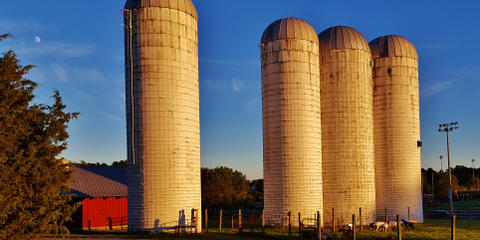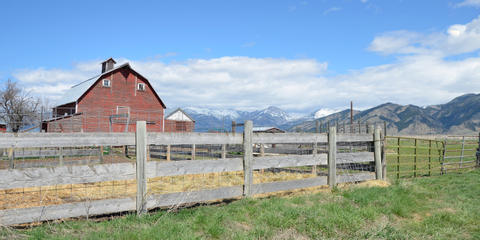Federal funding programs are under review as of 1/27/25. We'll make updates as new info is released.
The Risk Management Agency’s (RMA) Pasture, Rangeland, Forage (PRF) Pilot Insurance Program is designed to provide insurance coverage on pasture, rangeland, or forage acres. The PRF program utilizes a rainfall index to determine precipitation for coverage purposes, and does not measure production or loss of products themselves. The Rainfall Index uses National Oceanic and Atmospheric Administration Climate Prediction Center (NOAA CPC) data, which utilizes a grid system to determine precipitation amounts within an area. Each grid is 0.25 degrees in latitude by 0.25 degrees in longitude, which translates to approximately 17 by 17 miles at the equator. Acres will be assigned to one or more grids based on the location to be insured.
The Pasture, Rangeland, and Forage insurance was designed to help protect a producer’s operation from the risks of forage loss due to the lack of precipitation. It is not designed to insure against ongoing or severe drought, as the coverage is based on precipitation expected during specific intervals only.
Eligibility
PRF is available in the 48 contiguous states with the exception of a few grids that cross international borders.
Check the Actuarial Documents to see the deadline for buying PRF policies in your county.
Terms
Coverage and Claims
Coverage is based on a producer’s selection of coverage level, index intervals, and productivity factor. The index interval represents a two-month period, and the period selected should be the one when precipitation is most important to a producer’s operation. Policyholders can select a coverage level from 70 to 90 percent. The rainfall index does not measure direct production or loss. The producer is insuring a rainfall index that is expected to estimate production.
Producers select a productivity factor to match the amount of protection to the value of the production that best represents the operation and the productive capacity of the producer’s acres. Producers do not have to insure all acres. However, producers cannot insure more than total number of insurable acres.
Insurance payments are determined by using NOAA CPC data for their grid(s) and index intervals that were chosen to insure. When the final grid index falls below the policyholder’s “trigger grid index”, the producer may receive an indemnity. This insurance coverage is for a single peril -- lack of precipitation. Coverage is based on the experience of the entire grid. It is not based on individual farms or ranches or specific weather stations in the general area.
Tools
Producers need to make several choices when insuring their grazing or hay production, including coverage level, index intervals, irrigated practice, productivity factor, and number of acres. Producers should work with their crop insurance agent to view the Grid ID Locator map and index grids for their area, and assign acreage to one or more grids based on the location and use of the acreage to be insured. RMA encourages the use of the Grid ID Locator, historical indices tool, and decision support tools available on RMA’s website to help decide whether PRF is the right insurance coverage for a producer’s operation.
Application Instructions
PRF policies can be bought from a crop insurance agent by the sales closing date shown for each county in the actuarial documents. A list of crop insurance agents is available at all USDA service centers and on the RMA website at the Agent Locator.
Related Programs

Farm Storage Facility Loan Program (FSFL)
Farm Service Agency
- Loan
- Infrastructure
- Equipment
- Storage
- Lighting
- Delivery Vehicle
- National
- Oilseeds
- Peanuts
- Pulse Crops
- Hay
- Honey
- Biomass
- Fruits
- Vegetables
- Floriculture
- Hops
- Maple Sap
- Milk
- Cheese
- Yogurt
- Butter
- Eggs
- Rye
- Aquaculture
- Poultry
- Livestock
- Grains

ACRE3 Agricultural Energy Efficiency
Colorado Department of Agriculture
- Grant
- Cost Share
- Loan
- Alternative Energy
- Conservation
- Irrigation
- Storage
- Greenhouse
- CO
- Any

ACRE3 Irrigation Hydropower Programs
Colorado Department of Agriculture
- Grant
- Cost Share
- Loan
- Hydro Power
- Alternative Energy
- Irrigation
- Conservation
- Water Management
- Equipment
- CO
- Any

Agricultural Conservation Easement Program: Agricultural Land Easements (ACEP-ALE)
Natural Resources Conservation Service
- Easement
- Cost Share
- Conservation
- Waterway Protection
- Water Quality
- Wildlife & Pollinator Habitat
- Education
- Recreation
- Wetland Conservation
- National
- Any
Updated September 2, 2024
Image Credit: cwwycoff1
This information was gathered from public sources. Ambrook is not responsible for or able to affect the results of any financial programs listed, nor are they responsible for any incorrect information that is listed or is on the hyperlinked external sites. All information is subject to change.
Explore hundreds more programs on Ambrook.
